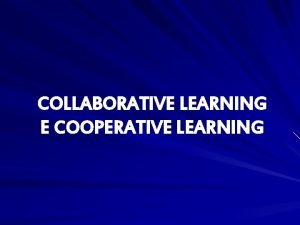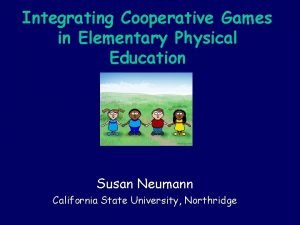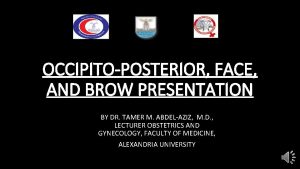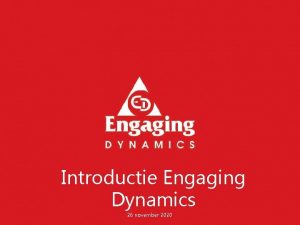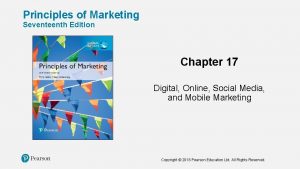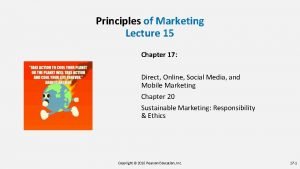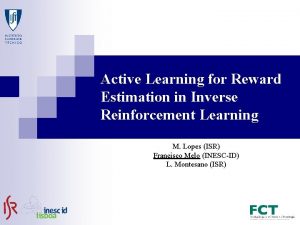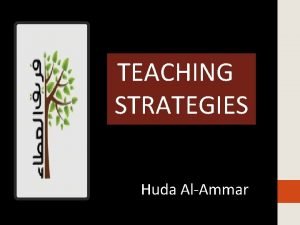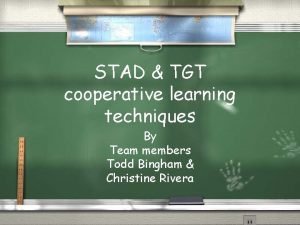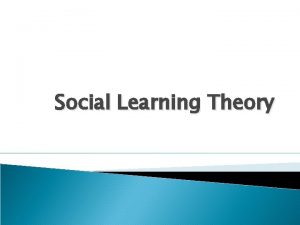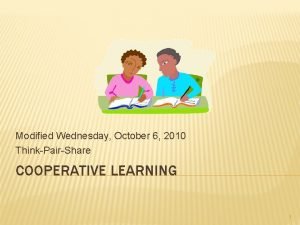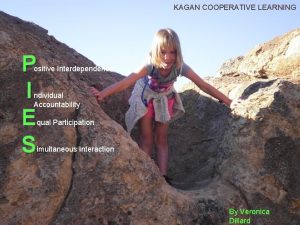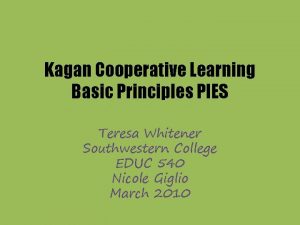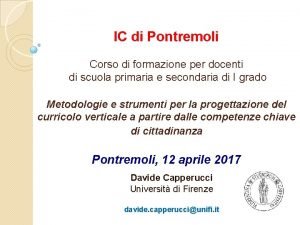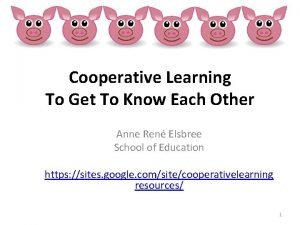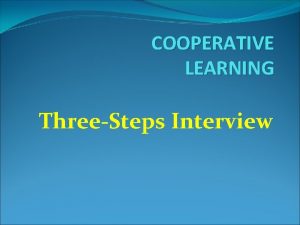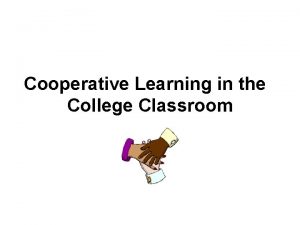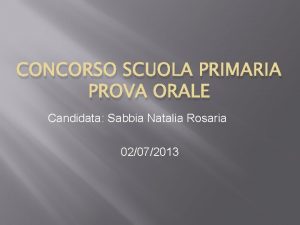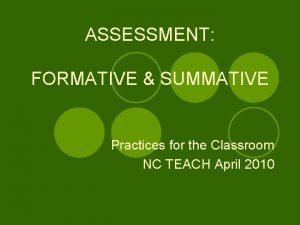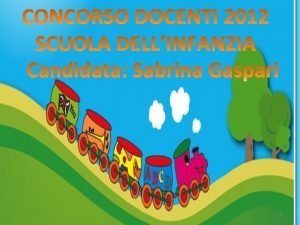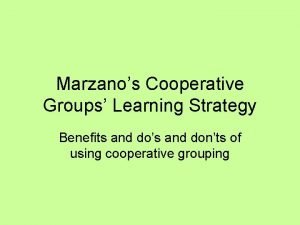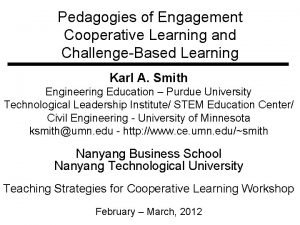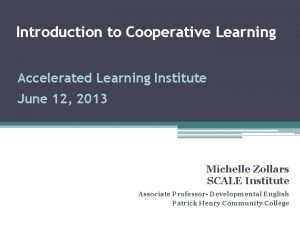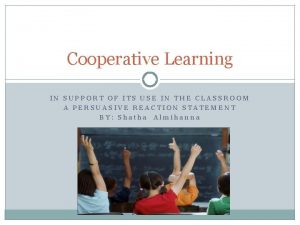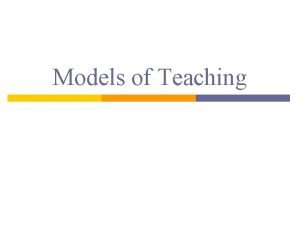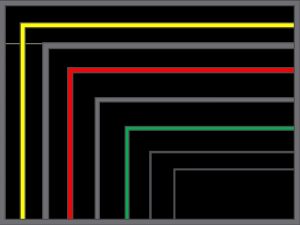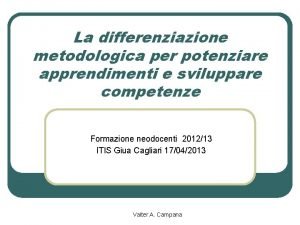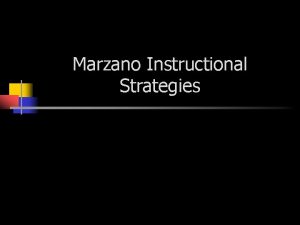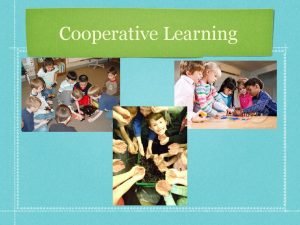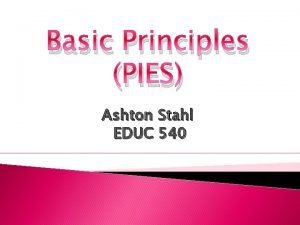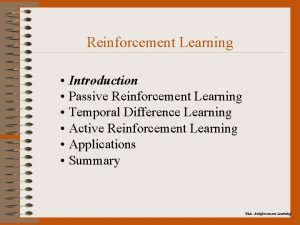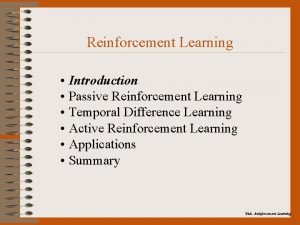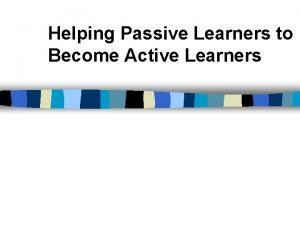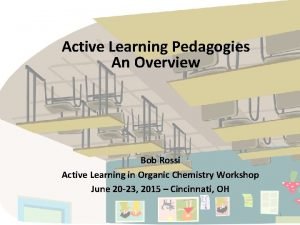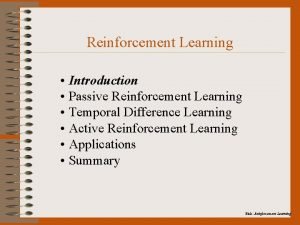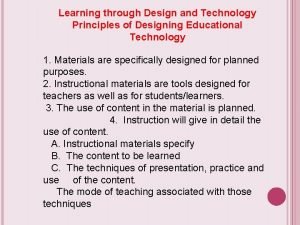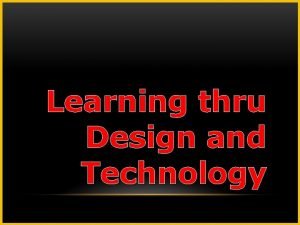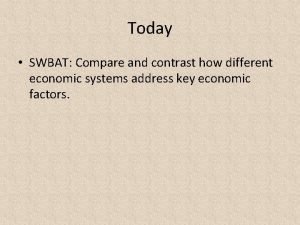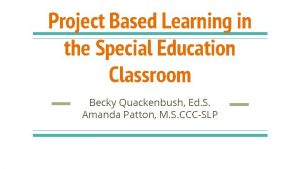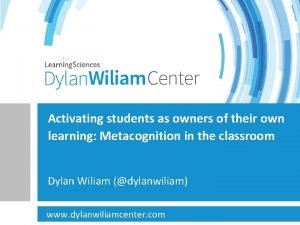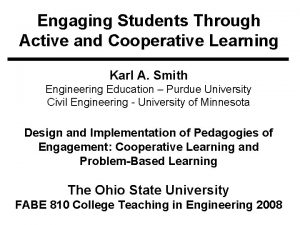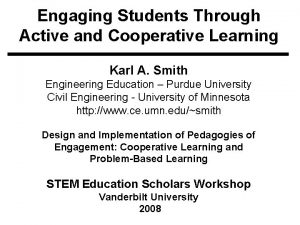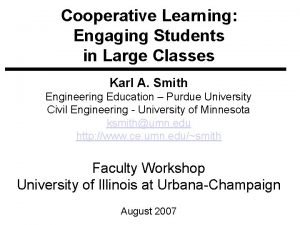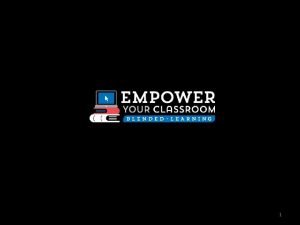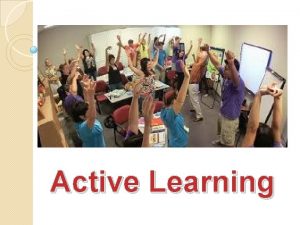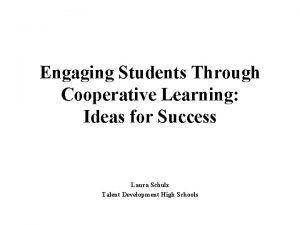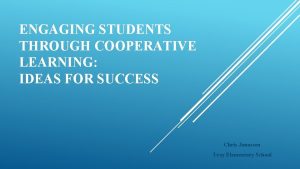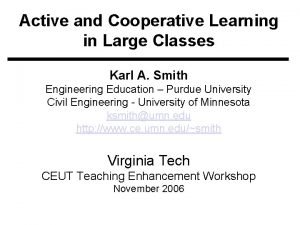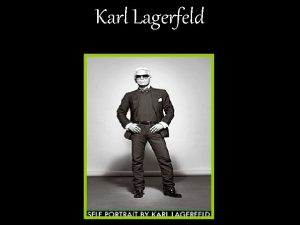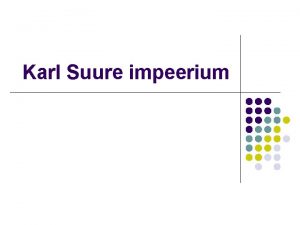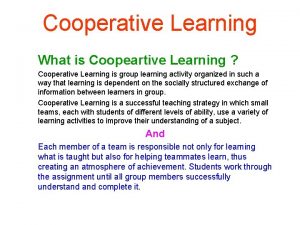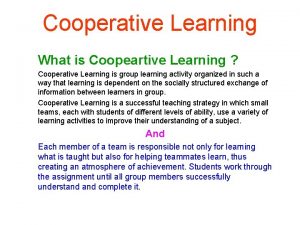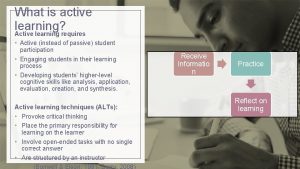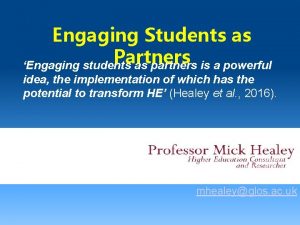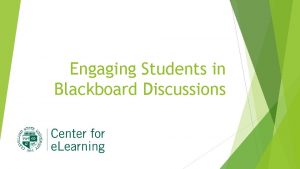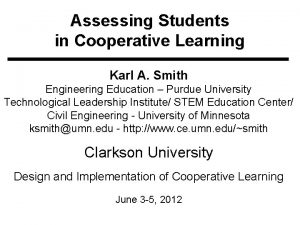Engaging Students Through Active and Cooperative Learning Karl






















































- Slides: 54

Engaging Students Through Active and Cooperative Learning Karl A. Smith Civil Engineering - University of Minnesota ksmith@umn. edu http: //www. ce. umn. edu/~smith Quarterly Forum – Spring 2005 Center for Instructional Development and Research University of Washington

To teach is to engage students in learning; thus teaching consists of getting students involved in the active construction of knowledge. . . The aim of teaching is not only to transmit information, but also to transform students from passive recipients of other people's knowledge into active constructors of their own and others' knowledge. . . Teaching is fundamentally about creating the pedagogical, social, and ethical conditions under which students agree to take charge of their own learning, individually and collectively Education for judgment: The artistry of discussion leadership. Edited by C. Roland Christensen, David A. Garvin, and Ann Sweet. Cambridge, MA: Harvard Business School, 1991.

Formulate-Share-Listen-Create (Think-Pair-Share) • Individually read the quote “To teach is to engage students in learning. . . ” • Underline/Highlight words and/or phrases that stand out for you • Turn to the person next to you and talk about words and/or phrases that stood out 3

Lila M. Smith

Pedago-pathologies Amnesia Fantasia Inertia Lee Shulman – MSU Med School – PBL Approach (late 60 s – early 70 s), Currently President of the Carnegie Foundation for the Advancement of College Teaching Shulman, Lee S. 1999. Taking learning seriously. Change, 31 (4), 11 -17.

What do we do about these pathologies? – Lee Shulman Activity Reflection Collaboration Passion Combined with generative content and the creation of powerful learning communities Shulman, Lee S. 1999. Taking learning seriously. Change, 31 (4), 11 -17. 6

Lila M. Smith

Cooperative Learning Task Groups Perkins, David. 2003. King Arthur's Round Table: How collaborative conversations create smart organizations. NY: Wiley.

Active/Cooperative Learning, Learning Community Success Story Reflect on and Talk about your Active/Cooperative Learning, Learning Community Success(es) 1. Context? 2. Structure/Procedure? 3. Outcome? 9

Key Features of Cooperative Learning Active/Interactive Cooperative Personal (before professional) Structure (before task) Knee-to-Knee, Eye-to-Eye/Space/Focus Challenging task (worthy of group effort) Students talking through the material (cognitive rehearsal) Learning groups are small (2 -5) and assigned Heterogeneous Your own cooperative group 10

Backdrop – Recent Reports National Research Council Reports: 1. How People Learn: Brain, Mind, Experience, and School (1999). 2. How People Learn: Bridging Research and Practice (2000). 3. Knowing What Students Know: The Science and Design of Educational Assessment (2001). 4. The Knowledge Economy and Postsecondary Education (2002). Chapter 6 – Creating High. Quality Learning Environments: Guidelines from Research on How People Learn 11

Designing Learning Environments Based on HPL (How People Learn) 12

Getting Students Actively Involved Using Cooperative Learning: Principles, Strategies, and Problem-Solving What is it? How do you do it? Why bother? 13

Cooperative Learning is instruction that involves people working in teams to accomplish a common goal, under conditions that involve both positive interdependence (all members must cooperate to complete the task) and individual and group accountability (each member is accountable for the complete final outcome). Key Concepts • Positive Interdependence • Individual and Group Accountability • Face-to-Face Promotive Interaction • Teamwork Skills • Group Processing

15

http: //clte. asu. edu/active 16

Robert Barr & John Tagg. From teaching to learning: A new paradigm for undergraduate education. Change, 27(6), 1995. Wm. Campbell & Karl Smith. New Paradigms for College Teaching. Interaction Books, 1997.

New Paradigm • Defining educational objectives, facilitating development of critical and creative thinking and problem-solving skills • Active learning (individual and group activities in class) • Structured cooperative learning (including multidisciplinary teamwork and facilitating development of written and oral communication skills) • Writing and (multidisciplinary) design across the curriculum • Inquiry and discovery learning (problem-based, casebased) • Teaching to diversity (different learning styles, ethnicities, genders) • Appropriate use of technology (tools, simulation, exploration)

Pressures to Change • Legislators (in public institutions) • National Science Foundation: Career Development Award, Shaping the Future • Professional Accreditation – ABET: Assessment, Synthesis & Design • Financial – especially the growing gap between the falling public support and the rising costs • Employers and Workforce Development Agencies: Workplace Basics, Global Engineer • University Administration Professional Organizations: Renewing the Covenant, Greater Expectations • Boyer Commission Reports: Educating Undergraduates in the Research Universities, Scholarship Reconsidered • Educational Research: Active, Interactive & Cooperative Learning, Inquiry & Problem-Based Learning

Business Week December 22, 1997

Shaping the Future: New Expectations for Undergraduate Education in Science, Mathematics, Engineering and Technology – National Science Foundation, 1996 Goal B All students have access to supportive, excellent undergraduate education in science, mathematics, engineering, and technology, and all students learn these subjects by direct experience with the methods and processes of inquiry. Recommend that SME&T faculty: Believe and affirm that every student can learn, and model good practices that increase learning; starting with the student=s experience, but have high expectations within a supportive climate; and build inquiry, a sense of wonder and the excitement of discovery, plus communication and teamwork, critical thinking, and 21 life-long learning skills into learning experiences.

Tracking Change - Seymour "The greatest single challenge to SMET pedagogical reform remains the problem of whether and how large classes can be infused with more active and interactive learning methods. " Seymour, Elaine. 2001. Tracking the processes of change in US undergraduate education in science, mathematics, engineering, and technology. Science Education, 86, 79 -105. 22

Active Learning: Cooperation in the College Classroom • Informal Cooperative Learning Groups • Formal Cooperative Learning Groups • Cooperative Base Groups 23

Book Ends on a Class Session 24

Book Ends on a Class Session 1. Advance Organizer 2. Formulate-Share-Listen-Create (Turn-to -your-neighbor) -- repeated every 10 -12 minutes 3. Session Summary (Minute Paper) 1. What was the most useful or meaningful thing you learned during this session? 2. What question(s) remain uppermost in your mind as we end this session? 3. What was the “muddiest” point in this session?

Advance Organizer “The most important single factor influencing learning is what the learner already knows. Ascertain this and teach him accordingly. @ David Ausubel - Educational psychology: A cognitive approach, 1968. 26

Knowledge Probe • Example from MOT 8221 • What would you like to know about the students in your courses? 27

28

MOT 8221 – Spring 2005 PM Q 1 IE/OR Q 6 PMI Q 2 Mod/Sim Q 7 KM Q 3 CAS Q 8 Leadership Q 4 Mgmt. Sci Q 9 Eng. Sys Q 5 6 Sigma Q 10 29

Spread Q 1 PM Q 2 Stat Q 3 Mod/Sim Q 4 DB Q 5 Prog Q 6 MOT 8221 – Spring 2005 30

Quick Thinks • Reorder the steps • Paraphrase the idea • Correct the error • Support a statement • Select the response Johnston, S. & Cooper, J. 1997. Quick thinks: Activethinking in lecture classes and televised instruction. Cooperative learning and college teaching, 8(1), 2 -7. 31

Formulate-Share-Listen-Create Informal Cooperative Learning Group Introductory Pair Discussion of a FOCUS QUESTION 1. Formulate your response to the question individually 2. Share your answer with a partner 3. Listen carefully to your partner's answer 4. Work together to Create a new answer through discussion 32

Minute Paper • What was the most useful or meaningful thing you learned during this session? • What question(s) remain uppermost in your mind as we end this session? • What was the “muddiest” point in this session? • Give an example or application • Explain in your own words. . . Angelo, T. A. & Cross, K. P. 1993. Classroom assessment techniques: A handbook for college teachers. San Francisco: Jossey Bass. 33

Informal CL (Book Ends on a Class Session) with Concept Tests Physics Peer Instruction Eric Mazur - Harvard B http: //galileo. harvard. edu Peer Instruction – www. prenhall. com Richard Hake – http: //www. physics. indiana. edu/~hake/ Chemistry Concep. Tests - UW Madison B www. chem. wisc. edu/~concept Video: Making Lectures Interactive with Concep. Tests Modular. Chem Consortium B http: //mc 2. cchem. berkeley. edu/ STEMTEC Video: How Change Happens: Breaking the ATeach as You Were Taught@ Cycle B Films for the Humanities & Sciences B www. films. com Thinking Together video: Derek Bok Center B www. fas. harvard. edu/~bok_cen/ 34

Richard Hake (Interactive engagement vs traditional methods) http: //www. physics. indiana. edu/~hake/ Traditional (lecture) Interactive (active/cooperative) <g> = Concept Inventory Gain/Total

36

The “Hake” Plot of FCI 35. 00 SDI 30. 00 X ALS UMn-CL+PS WP 25. 00 20. 00 UMn Cooperative Groups 15. 00 X PI(HU) UMn Traditional ASU(nc) 10. 00 WP* ASU(c) HU 5. 00 0. 00 20. 00 30. 00 40. 00 50. 00 37 (Percent) Pretest 60. 00 70. 00 80. 00

Physics (Mechanics) Concepts: The Force Concept Inventory (FCI) • A 30 item multiple choice test to probe student's understanding of basic concepts in mechanics. • The choice of topics is based on careful thought about what the fundamental issues and concepts are in Newtonian dynamics. • Uses common speech rather than cueing specific physics principles. • The distractors (wrong answers) are based on students' common inferences. 38

Session Summary (Minute Paper) Reflect on the session: 1. Most interesting, valuable, useful thing you learned. 2. Question/Topic/Issue you would like to have addressed. 3. Comments, suggestions, etc 4. Pace: Too slow 1. . 5 Too fast 5. Relevance: Little 1. . . 5 Lots 6. Format: Ugh 1. . . 5 Ah 39

MOT 8221 - Spring 2005 - Session 1 Q 4 – Pace: Too slow 1. . 5 Too fast Q 5 – Relevance: Little 1. . . 5 Lots Q 6 – Format: Ugh 1. . . 5 Ah 40

Mid-Term Review http: //eval. umn. edu 41

42

Informal Cooperative Learning Groups Can be used at any time Can be short term and ad hoc May be used to break up a long lecture Provides an opportunity for students to process material they have been listening to (Cognitive Rehearsal) Are especially effective in large lectures Include "book ends" procedure Are not as effective as Formal Cooperative Learning or Cooperative Base Groups

Cooperative Learning Research Support Johnson, D. W. , Johnson, R. T. , & Smith, K. A. 1998. Cooperative learning returns to college: What evidence is there that it works? Change, 30 (4), 26 -35. • Over 300 Experimental Studies • First study conducted in 1924 • High Generalizability • Multiple Outcomes 1. Achievement and retention 2. Critical thinking and higher-level reasoning 3. Differentiated views of others 4. Accurate understanding of others' perspectives 5. Liking for classmates and teacher 6. Liking for subject areas 7. Teamwork skills

Small-Group Learning: Meta-analysis Springer, L. , Stanne, M. E. , & Donovan, S. 1999. Effects of small-group learning on undergraduates in science, mathematics, engineering, and technology: A metaanalysis. Review of Educational Research, 69(1), 21 -52. Small-group (predominantly cooperative) learning in postsecondary science, mathematics, engineering, and technology (SMET). 383 reports from 1980 or later, 39 of which met the rigorous inclusion criteria for meta-analysis. The main effect of small-group learning on achievement, persistence, and attitudes among undergraduates in SMET was significant and positive. Mean effect sizes for achievement, persistence, and attitudes were 0. 51, 0. 46, and 0. 55, respectively.

Strategies for Energizing Large Classes: From Small Groups to Learning Communities: Jean Mac. Gregor, James Cooper, Karl Smith, Pamela Robinson New Directions for Teaching and Learning, No. 81, 2000. Jossey- Bass

Formal Cooperative Learning Task Groups

Formal Cooperative Learning 1. Jigsaw 2. Peer Composition or Editing 3. Reading Comprehension/Interpretation 4. Problem Solving, Project, or Presentation 5. Review/Correct Homework 6. Constructive Academic Controversy 7. Group Tests

Challenged-Based Learning • • • Problem-based learning Case-based learning Project-based learning Learning by design Inquiry learning Anchored instruction John Bransford, Nancy Vye and Helen Bateman. Creating High-Quality Learning Environments: Guidelines from Research on How People Learn 49

Professor's Role in Formal Cooperative Learning 1. Specifying Objectives 2. Making Decisions 3. Explaining Task, Positive Interdependence, and Individual Accountability 4. Monitoring and Intervening to Teach Skills 5. Evaluating Students' Achievement and Group Effectiveness 50

Problem Based Cooperative Learning Format TASK: Solve the problem(s) or Complete the project. INDIVIDUAL: Estimate answer. Note strategy. COOPERATIVE: One set of answers from the group, strive for agreement, make sure everyone is able to explain the strategies used to solve each problem. EXPECTED CRITERIA FOR SUCCESS: Everyone must be able to explain the strategies used to solve each problem. EVALUATION: Best answer within available resources or constraints. INDIVIDUAL ACCOUNTABILITY: One member from your group may be randomly chosen to explain (a) the answer and (b) how to solve each problem. EXPECTED BEHAVIORS: Active participating, checking, encouraging, and elaborating by all members. INTERGROUP COOPERATION: Whenever it is helpful, check procedures, 51 answers, and strategies with another group.

Cooperative Base Groups • Are Heterogeneous • Are Long Term (at least one quarter or semester) • Are Small (3 -5 members) • Are for support • May meet at the beginning of each session or may meet between sessions • Review for quizzes, tests, etc. together • Share resources, references, etc. for individual projects • Provide a means for covering for absentees 52

It could well be that faculty members of the twenty-first century college or university will find it necessary to set aside their roles as teachers and instead become designers of learning experiences, processes, and environments. James Duderstadt, 1999 We never educate directly, but indirectly by means of the environment. Whether we permit chance environments to do the work, or whether we design environments for the purpose makes a great difference. 53 John Dewey, 1906

Session Summary (Minute Paper) Reflect on the session: 1. What were the most important points for you? 2. What is one thing you would be willing to try? 3. What questions do you have? Discuss with a partner: 1. Points that were useful, meaningful, interesting, applicable, etc. 2. Questions that you have. 54
 Collaborative learning vs cooperative learning
Collaborative learning vs cooperative learning Cooperative games in physical education
Cooperative games in physical education Brow presentation
Brow presentation Engaging dynamics
Engaging dynamics Marketing involve engaging directly with carefully targeted
Marketing involve engaging directly with carefully targeted Marketing involve engaging directly with carefully targeted
Marketing involve engaging directly with carefully targeted Passive learning vs active learning
Passive learning vs active learning Active learning reinforcement learning
Active learning reinforcement learning Cooperative vs collaborative learning
Cooperative vs collaborative learning Tgt cooperative learning
Tgt cooperative learning Learning theory definition
Learning theory definition Cooperative learning ideatore
Cooperative learning ideatore Think pair share cooperative learning
Think pair share cooperative learning Kagan pies
Kagan pies Pies principles
Pies principles Griglie di osservazione sostegno scuola secondaria
Griglie di osservazione sostegno scuola secondaria Pigs face cooperative learning
Pigs face cooperative learning Three-step interview
Three-step interview Examples of cooperative learning
Examples of cooperative learning Griglia di osservazione cooperative learning
Griglia di osservazione cooperative learning Evaluation continuum
Evaluation continuum Griglia di osservazione cooperative learning
Griglia di osservazione cooperative learning Marzano cooperative learning
Marzano cooperative learning Formal cooperative learning
Formal cooperative learning Cooperative learning institute
Cooperative learning institute Types of cooperative learning
Types of cooperative learning Model of cooperative learning
Model of cooperative learning Laboratory method of teaching
Laboratory method of teaching Cooperative learning
Cooperative learning Marzano instructional strategies
Marzano instructional strategies Formal cooperative learning
Formal cooperative learning Cooperative learning round robin
Cooperative learning round robin Pies prensiles
Pies prensiles Through and through sawing advantages
Through and through sawing advantages Vicenta ybardaloza
Vicenta ybardaloza Active high and active low
Active high and active low Primary active transport and secondary active transport
Primary active transport and secondary active transport Cuadro comparativo entre e-learning b-learning y m-learning
Cuadro comparativo entre e-learning b-learning y m-learning The librarian read the book to the students. active passive
The librarian read the book to the students. active passive By one man sin
By one man sin Furcation involvement
Furcation involvement Night of the scorpion written by
Night of the scorpion written by Primary active transport vs secondary active transport
Primary active transport vs secondary active transport Active passive reinforcement learning
Active passive reinforcement learning Passive reinforcement learning
Passive reinforcement learning Passive and active learning
Passive and active learning What is the difference between passive and active learning
What is the difference between passive and active learning Passive learning
Passive learning Passive reinforcement learning
Passive reinforcement learning Learning through design and technology
Learning through design and technology Principles of educational technology
Principles of educational technology Compare and contrast, karl marx and adam smith venn diagram
Compare and contrast, karl marx and adam smith venn diagram Project based learning for special education
Project based learning for special education Activating students as owners of their own learning
Activating students as owners of their own learning Learning target
Learning target
